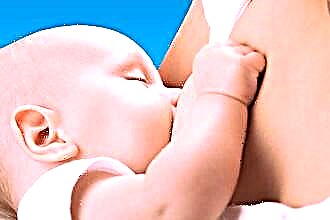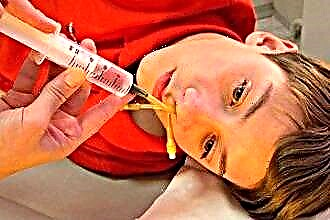Unlike a common cold in adults, the appearance of snot in infants becomes a real problem for young parents and the newborn itself. Difficulties lie in the high risk of complications and the small selection of medicines that are allowed for infants. How to treat a cold in a newborn? The drugs prescribed for rhinitis should have a decongestant, anti-inflammatory, antiseptic and immunomodulatory effect. Only a comprehensive therapeutic approach can quickly alleviate the condition of the little patient and reassure the parents.
A runny nose in newborns can be provoked by:
 viral infection. Babies should limit communication with a person suffering from a viral disease or the latter - use a protective disposable mask;
viral infection. Babies should limit communication with a person suffering from a viral disease or the latter - use a protective disposable mask;- a cold, when the child is in a draft or in a cold room for a long time, which is why it freezes over a lot;
- allergen. This can be fluff, pollen, new complementary foods, drugs, wool, hygiene products, or dust mites.
- irritating environmental factors. If the air in the room is dry and the concentration of dust is increased, the mucous membrane of the nasal passages can produce more mucus for self-cleaning.
Do not forget that snot in a newborn can be a manifestation of a physiological rhinitis. Its development is due to the adaptation of the mucous membrane to the aggressive action of environmental factors. In utero, she is in contact only with amniotic fluid. In the postpartum period, the mucous membrane is negatively affected by dust particles, allergens, chemicals, which is why hypersecretion is noted.
Physiological nasal discharge in newborns can appear immediately after birth and decrease in volume at 8-10 weeks of life.
Microclimate
Babies need to start treating snot by improving living conditions. This requires:
 air the room twice a day;
air the room twice a day;- carry out wet cleaning daily - to reduce the concentration of allergens, microbes and dust in the air;
- remove from the nursery "dust collectors", namely books, carpets, decorative pillows;
- maintain air humidity at 65%, which will prevent drying out of the mucous membrane and facilitate breathing;
- reduce the temperature to 19 degrees.
Remember that it is difficult for a newborn to breastfeed due to severe nasal congestion. For full development, babies need a certain amount of nutrients per day. The main task of parents is to provide nutrition and prevent weight loss.
Drug therapy
To cure rhinitis in infants, it is necessary to use drugs for intranasal administration, as well as supplement therapy with inhalation.
Depending on the cause of the disease, treatment can be carried out using drugs such as:
- vasoconstrictor (Nazivin);
- saline (Morenazal, Aqua Maris);
- antiseptic;
- homeopathic.
Antiseptic drugs such as Miramistin, Furacilin can be administered by inhalation. In addition, inhalations with saline, non-carbonated mineral water (Borzhomi, Essentuki) are effective. They are recommended for the prevention and treatment of diseases of the upper respiratory tract.
Their action is aimed at:
- moisturizing the mucous membrane;
- cleansing tissues from mucus accumulations;
- decrease in the viscosity of mucous secretions;
- relief of nasal breathing;
- improving the work of the cilia of the epithelium;
- regulation of secretion;
- increasing the protective properties against irritants and infections.
Antiviral agents
For colds and viral rhinitis, Grippferon is prescribed. It has a wide antiviral spectrum (influenza viruses, adeno-, corona-, rhinoviruses). After instillation of the nasal passages, it protects the mucous membrane from secondary infection and fights viruses.
Grippferon is not addictive, so it can be used prophylactically.
The therapeutic effect can be enhanced by vasoconstrictor, antiseptic drugs. In the first hours after the instillation of the nasal passages, a relief of the general condition is observed - the runny nose, headache, hyperemia of the mucous membrane of the posterior pharyngeal wall decrease, and the temperature also normalizes.
The use of Grippferon can reduce the duration of the disease in half and avoid complications. When using the drug in a prophylactic dose, the risk of viral infection during an epidemic is only 5%.
Contraindications include allergic rhinitis and individual intolerance to the constituents of the drug.
A remedy for the common cold for newborns should be used when the first symptoms of rhinitis appear. The baby is prescribed a drop in each nostril up to five times a day. A single dose is 1000 IU, a daily dose is 5 thousand.
For prophylactic purposes, the drug is used after hypothermia or communication with a person suffering from a viral pathology. It is recommended to bury the nasal passages twice a day, drop by drop for 5 days.
During a flu epidemic every other day, you can instill the medicine drop by drop once a day (preferably in the morning). After administration of the solution, the wings of the nose should be massaged to evenly distribute it, activate local blood flow and accelerate the absorption of the drug.
Immunostimulants
Derinat's action is aimed at activating immune links. It stimulates defense reactions against bacterial, viral, fungal infections.
In addition, Derinat activates regeneration, normalizes metabolism and tissue nutrition. The drug is prescribed for prophylactic and therapeutic purposes for ARVI.

The only contraindication is presented by individual intolerance to the components of the drug.
The drug is administered intranasally dropwise three times a day. The duration of the therapeutic course is 1-2 weeks. When the first symptoms of a cold appear, the frequency of instillation can be increased up to 5 times.
Derinat is approved for inhalation. For the procedure, you must prepare a solution. To do this, the contents of the ampoule should be mixed with saline (1: 4). Inhalation lasts 3-4 minutes.
Derinat can be used from the first days of life.
Vasoconstrictor drugs
The main active ingredient of Nazivin is oxymetazoline. Depending on its concentration, the drug can be purchased in the form of a 0.01% solution, which is used for infants, 0.025% (after a year), as well as a 0.05% solution (from six years).
The action of the drug is aimed at reducing the swelling of the nasal mucosa, the volume of mucous secretions and facilitating breathing. The therapeutic effect is due to local vasospasm, which develops after the solution is absorbed into the mucous membrane.
Contraindications
 Among the contraindications, it should be noted:
Among the contraindications, it should be noted:
- atrophic type of rhinitis;
- individual intolerance to oxymetazoline;
- severe heart failure;
- pheochromocytoma;
- diabetes;
- increased levels of thyroid hormones in the bloodstream.
The duration of vasospasm can last up to 12 hours, and therefore the use of the drug more than twice a day is prohibited.
Dosage, adverse reactions
For babies with a cold, it is prescribed drop by drop twice a day. Two drops are buried starting from the second month of life. In addition to drip application, you can apply the solution to a cotton swab and lubricate the nasal mucosa.
After nasal instillation, a newborn child may experience:
- baking sensations, dryness of the mucous membrane;
- severe nasal congestion;
- drowsiness;
- headache;
- hallucinations;
- heart palpitations;
- arterial hypertension.
Saline solutions
A solution based on sea salt Morenazal helps to maintain the physiological state of the tissues of the nose, cleanse the mucous membrane, reduce the viscosity of mucus, and facilitate its outflow. In addition, the drug increases the resistance of the mucous membrane to the irritating effects of environmental factors.
The drug is prescribed for regular cleansing of the inner surface of the nose from allergens, microbes, which is the prevention of infection, the development of an allergic reaction.
Morenazal is used for the treatment of rhinitis of various origins, as well as for preliminary cleansing of the mucous membrane before instilling the nasal passages with medicinal drops (antiseptic, antihistamines).
Morenazal is applied intranasally from the first day of life, 2 drops three times a day. The duration of the course is 2-4 weeks. If necessary, the course can be repeated in a month.
Continuous use of saline solutions can disrupt the composition of the microflora of the nasopharynx, which is fraught with the activation of a fungal infection.
The solution can be instilled to soften dry crusts. To do this, you need to drop 2 drops, wait a minute and remove mucus using a special aspirator with a soft tip.
Antiseptics
From the first days of life, Sialor (Protargol) is prescribed for the treatment of an infectious rhinitis. It contains silver proteinate, which is harmful to microbes.
The drug can be used for treatment, as well as prevention during periods of viral disease epidemics.
Long-term use of Protargol is not accompanied by a decrease in the effectiveness of the drug and does not cause tachyphylaxis (addiction).
Numerous studies have proven the higher effectiveness of Protargol in comparison with local antibacterial drugs. According to the instructions, the medicinal product:
- has an antiseptic effect, cleansing the nasal passages of infectious pathogens;
- protects and maintains the physiological composition of microflora. A solution based on silver does not have a bactericidal effect on opportunistic microorganisms;
- reduces the severity of the inflammatory reaction, swelling and tissue irritation.
Mode of application
 The Sialor package contains:
The Sialor package contains:
- 1 tablet with a dose of 200 mg in a blister;
- solvent with a volume of 10 ml;
- dilution bottle with a convenient pipette cap designed especially for toddlers;
- instruction.
Please note that some packages contain a bottle with a spray nozzle. The spray is allowed only from the age of 16. To prepare a medicine, you must:
- open the container with the solvent liquid;
- pour it into a bottle;
- remove the tablet from the blister, add to the bottle. We emphasize that the structure of silver proteinate changes somewhat under the influence of air, therefore, the tablet should not be open for a long time;
- close the bottle tightly;
- mix thoroughly until complete dissolution. This usually takes up to 10 minutes. The solution acquires a dark brown color and a specific odor.
The medicinal product retains its healing properties for a month after preparation. The bottle must be tightly closed, otherwise, under the influence of air, bright sunny color, high temperatures, the solution changes its properties. Children should not have access to these drugs.
Sialor for intranasal administration is approved for use from the first months of life. Application of the drug is recommended after cleansing the nasal mucosa with saline. It is recommended daily, drop by drop, three times a day. Sometimes the dosage can be increased to 2 drops three times.
The duration of the course is 5-7 days.
Adverse Reactions
Usually the drug is well tolerated, but sometimes there is a slight burning sensation in the nasal passages. If instilled incorrectly, the medicinal solution may drip down the back of the pharynx with the appearance of an unpleasant taste in the mouth (with a metallic tinge).
The disadvantages of the drug include a short shelf life, because for the treatment of a cold, about a third of the bottle is usually consumed. The remains of the medicine have to be disposed of.
In treating infants, it is important to find effective, and at the same time, safe medicines. This will quickly heal the newborn and avoid complications.

 viral infection. Babies should limit communication with a person suffering from a viral disease or the latter - use a protective disposable mask;
viral infection. Babies should limit communication with a person suffering from a viral disease or the latter - use a protective disposable mask; air the room twice a day;
air the room twice a day;

